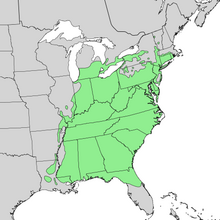Liriodendron tulipifera
| Liriodendron tulipifera | |
|---|---|
 |
|
|
Liriodendron tulipifera cultivated at Laken Park in Belgium |
|
| Scientific classification | |
| Kingdom: | Plantae |
| (unranked): | Angiosperms |
| (unranked): | Magnoliids |
| Order: | Magnoliales |
| Family: | Magnoliaceae |
| Genus: | Liriodendron |
| Species: | L. tulipifera |
| Binomial name | |
|
Liriodendron tulipifera L. |
|
 |
|
| Range | |
| Synonyms | |
|
|
Liriodendron tulipifera—known as the tulip tree, American tulip tree, tuliptree, tulip poplar, whitewood, fiddle-tree, and yellow poplar—is the Western Hemisphere representative of the two-species genus Liriodendron, and the tallest eastern hardwood. It is native to eastern North America from Southern Ontario and Illinois eastward to southeastern Massachusetts and Rhode Island, and south to central Florida and Louisiana. It can grow to more than 50 m (160 ft) in virgin cove forests of the Appalachian Mountains, often with no limbs until it reaches 25–30 m (80–100 ft) in height, making it a very valuable timber tree. It is fast-growing, without the common problems of weak wood strength and short lifespan often seen in fast-growing species. April marks the start of the flowering period in the southern USA (except as noted below); trees at the northern limit of cultivation begin to flower in June. The flowers are pale green or yellow (rarely white), with an orange band on the tepals; they yield large quantities of nectar. The tulip tree is the state tree of Indiana, Kentucky, and Tennessee.
The tulip tree is one of the largest of the native trees of the eastern United States, known to reach the height of 60 m (190 ft), with a trunk 3 m (10 ft) in diameter; its ordinary height is 20 to 30 m (70 to 100 ft). It prefers deep, rich, and rather moist soil; it is common, though not abundant, nor is it solitary. Its roots are fleshy. Growth is fairly rapid, and the typical form of its head is conical.
...
Wikipedia

